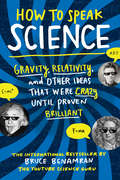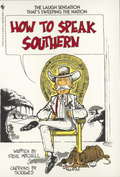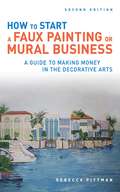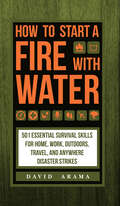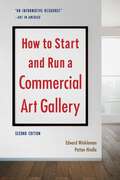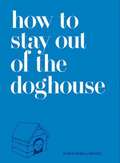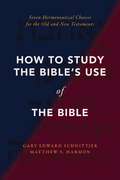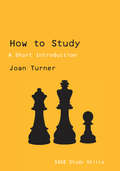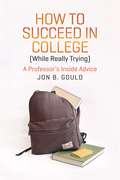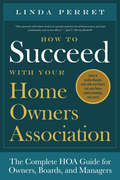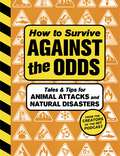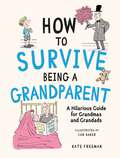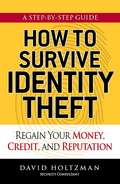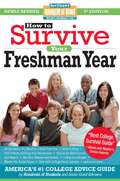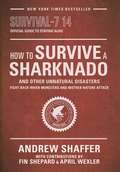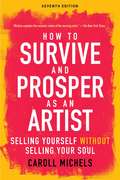- Table View
- List View
How to Speak Science: Gravity, Relativity, and Other Ideas That Were Crazy Until Proven Brilliant
by Bruce BenamranAs smartphones, supercomputers, supercolliders, and AI propel us into an ever more unfamiliar future, How to Speak Science takes us on a rollicking historical tour of the greatest discoveries and ideas that make today’s cutting–edge technologies possible. Wanting everyone to be able to “speak” science, YouTube science guru Bruce Benamran explains–as accessibly and wittily as in his acclaimed videos–the fundamental ideas of the physical world: matter, life, the solar system, light, electromagnetism, thermodynamics, special and general relativity, and much more. Along the way, Benamran guides us through the wildest hypotheses and most ingenious ideas of Galileo, Newton, Curie, Einstein, and science’s other greatest minds, reminding us that while they weren’t always exactly right, they were always curious. How to Speak Science acquaints us not only with what scientists know, but how they think, so that each of us can reason like a physicist–and appreciate the world in all its beautiful chaos.
How to Speak Southern
by Steve MitchellThe laugh sensation that swept the nation, How to Speak Southern and More How to Speak Southern, is now collected in one complete--and completely hilarious--volume. Embraced by Southerners everywhere and dedicated to all Yankees in the hope that it will teach them to talk right, this uproarious book decodes "Suthun" wit and wisdom for "Nawthun" upstarts everywhere. From "aig" (a breakfast food that may be fried, scrambled, boiled, or poached) to "zackly" (as in "precisely"), here's just a sampling of what you'll find inside: ATTAIR: Contraction used to indicate the specific item desired. "Pass me attair gravy, please." EVERWHICHAWAYS: To be scattered in all directions. "You should have been there when the train hit that chicken truck. Them chickens flew everwhichaways." YONTNY: Do you want any. "Yontny more corn bread?" Funny as well as informative, this laugh-out-loud dictionary will keep you laughing and learning--no matter where you fall on the Mason-Dixon Line!
How to Speak Tech
by Vinay Trivedi"A great book everyone can use to understand how tech startups work. " --Rene Reinsberg, GM/VP at GoDaddy, CEO and Co-founder at Locu "Finally a book non-techies can use to understand the web technologies that are changing our lives. " --Paul Bottino, Executive Director, Technology and Entrepreneurship Center, Harvard University "Through the simplicity of his presentation, Vinay shows that the basics of technology can be straightforwardly understood by anyone who puts in the time and effort to learn. " --Joseph Lassiter, Professor of Management Science, Harvard Business School and Harvard Innovation Lab In a way that anyone can understand, How to Speak Tech: The Non-Techie''s Guide to Tech Basics in Business spells out the essential technical terms and technologies involved in setting up a company''s website or web application. Nontechnical business readers will find their digital literacy painlessly improved with each ten-minute chapter of this illustrative story of one successful technology startup building its Web-based business from scratch. Vinay Trivedi--a private equity analyst and startup entrepreneur who works at the intersection of business and tech--employs the startup story line as his frame for explaining in plain language the technology behind our daily user experiences, the successful strategies of social media giants, the bold aspirations of tiny startups, and the competitive adaptations of ordinary businesses of all sizes and sectors. Along the way, he demystifies all those tech buzzwords in our business culture whose precise meanings are so often elusive even to the people using them. Internet hardware, application software, and business process: the working premise of this book is that none of it is beyond the basic understanding of nontechnical business readers. Trivedi peels back the mystery, explains it all in simplest terms, and gives his readers the wherewithal to listen intelligently and speak intelligibly when the subject turns to technology in business. What you''ll learn Website hosts and programming languages for web apps on the backend Performance and scalability APIs, open-source programs, feeds, and database management Design and display on the front end Who this book is for Primary readership: nontechnical business people who want to firm up their understanding of the technology of the Internet and their fluency with technical terms in widespread use in the business world. Secondary readership: Digital immigrants in the general-interest mainstream who are looking for a short, accessible, and comprehensive treatment of Internet technology and business to inform their personal experience as consumers and generators of Internet content and value. Table of Contents Chapter 1. The Internet Chapter 2. Hosting and the Cloud Chapter 3. The Back End: Programming Languages Chapter 4. The Front End: Presentation Chapter 5. Databases: The Model Chapter 6. Leveraging Existing Code: APIs, Libraries, Web Services, and Open-Source Projects Chapter 7. Software Development: Working in Teams Chapter 8. Software Development: The Process Chapter 9. Software Development: Debugging and Testing Chapter 10. Promotion and Tracking: Attracting and Understanding Your Users Chapter 11. Performance and Scalability Chapter 12. Security Threats: To Defend and Protect
How to Start a Faux Painting or Mural Business: A Guide To Making Money In The Decorative Arts
by Rebecca F. PittmanThis second edition is updated and expanded to cover better ways to advertise, innovative supplies (such as Venetian plasters and stained cements), unique bidding and studio setups required for new plasters and varnishes, the use of the Internet both for marketing and shopping for materials, new product lines, and the latest trends in the industry. Artists ready to turn their faux, mural, and decorative painting skills into a career will find everything they need to know to start a home-based business. Readers will find insider tips on bidding and client interaction that can turn an artist into an entrepreneur. This essential guide highlights the fundamentals of getting started, from necessary office supplies to insurance needs, from building a portfolio to finding potential clients. Also covered are such crucial topics as keeping records, dealing with supply stores, getting referrals, interviewing with clients, evaluating job sites, negotiating prices, handling contracts, and coping with the growing pains of a successful business. Handy checklists and useful forms such as sample contracts, client invoices, and record-keeping charts, will help launch the business. Anyone who has ever dreamed of making money from his or her faux or mural painting, stencil, furniture decoration, and other skills must have this comprehensive resource.
How to Start a Fire with Water: 501 Essential Survival Skills for Home, Work, Outdoors, Travel, and Anywhere Disaster Strikes
by David AramaLife is unpredictable—are you prepared for it?Should disaster ever strike, you'll feel prepared with this book as your guide. Inside you'll find tips and tricks for surviving unpredictable situations at home, work, outdoors, and while traveling. From natural catastrophes such as lightning strikes, wildfire, floods, earthquakes, and tornadoes to man-made dangers such as car accidents, plane crashes, and electrical fires, this book will help you take the first steps to survival—being prepared.
How to Start a Home-based Dog Training Business (Home-Based Business Series)
by Peggy O. SwagerThe demand for skilled dog trainers has never been greater. To succeed in one of this field, you'll need more than dog expertise you'll need business savvy as well. Written for the non-business person, this book provides the information you need to start, operate, and prosper in your chosen field of dog training. Beginning with an overview of the different areas to create a dog training business, the book provides what it takes to break into and succeed in the top dog training fields. Readers learn what associations they need to become a part of as well as how to build counsel, structure, and support. Marketing information helps people expand and grow their business. Tips from a variety of established dog trainers gives this book an edge above the competition.
How to Start and Run a Commercial Art Gallery (Second Edition)
by Edward Winkleman Patton Hindle"A comprehensive reference for any gallery owner." —Leigh Conner, director, Conner Contemporary Art Aspiring and new art gallery owners can find everything they need to plan and operate a successful art gallery with How to Start and Run a Commercial Art Gallery. This new edition has been updated to mark the changes in market and technology over the past decade. Edward Winkleman and Patton Hindle draw on their years of experience to explain step by step how to start your new venture. From finding the ideal locale and renovating the space to writing business plans and securing start-up capital, this helpful guide has it all. Chapters detail how to: Manage cash flow Grow your new business Hire and manage staff Attract and retain artists and clients Represent your artists Promote your gallery and artists online Select the right art fair And moreHow to Start and Run a Commercial Art Gallery, Second Edition, also includes sample forms, helpful tips from veteran collectors and dealers, a large section on art fairs, and a directory of art dealer associations.
How to Stay Out of the Doghouse
by Partners Spade Jason Musante Josh RubinAs men, we can't help ending up in the doghouse for simply following our natural instincts. But follow the 50 tips in this book, and you'll spend less time out in the cold and more time getting scratches behind the ears and belly rubs.
How to Stay Out of the Doghouse
by Partners Spade Jason Musante Josh RubinAn elegantly cheeky guide to keeping the woman in your life happy--while secretly doing whatever you want. Published in tandem with the woman's guide How to Keep Him on a Short Leash, How to Stay Out of the Doghouse is perfect for Father's Day.... or as a gift for a new groom.
How to Steal the Mona Lisa
by Taylor BayouthA step-by-step guide for the craft of high stakes thievery In How to Steal the Mona Lisa, author Taylor Bayouth meticulously describes seven heists of priceless art and artifacts: the Hope Diamond, the "Mona Lisa," the Archaeopteryx Lithographica, Rodin's "Thinker," King Tut's golden death mask, the Crown Jewels, and the Codex Leicester. With this trusty guide, learn to: - Camouflage a getaway car. - Hack security systems. - Navigate air ducts. - Master the art of disguise. - Pick locks, scale buildings, and more. Illustrated throughout, this book contains all the information you need to acquire equipment, recruit partners, strategize the perfect crime, and discreetly sell off your stolen national treasures.From the Trade Paperback edition.
How to Study the Bible's Use of the Bible: Seven Hermeneutical Choices for the Old and New Testaments
by Matthew S. Harmon Gary Edward SchnittjerHow to Study the Bible's Use of the Bible: Seven Hermeneutical Choices for the Old and New Testaments by Gary Edward Schnittjer and Matthew S. Harmon is an essential resource aimed at teaching a hermeneutic for understanding the Bible's use of the Bible. Intended for students of both testaments, the book's innovative approach demonstrates how the Old Testament use of Scripture provides resources for the New Testament authors' use of Scripture. The authors provide students with a clear approach to handling the Bible's use of itself through seven key hermeneutical choices organized into individual chapters. Each chapter introduces a hermeneutical choice and then provides several examples of the Old Testament use of Old Testament and the New Testament use of Old Testament. The plentiful examples model for students the need to ground hermeneutics in biblical evidence and provide insight into understanding why the Bible's use of the Bible is important.
How to Study: A Short Introduction (SAGE Study Skills Series)
by Joan TurnerAny student can improve their learning in higher education if they want to, and the aim of this guide is to help you along this route, not by claiming there is only one right way to do things but by building awareness of different approaches, attitudes, and strategies. Key to this is the notion of active learning which is highlighted throughout the book with the acronym ASCERTAIN whose individual letters signal a range of different strategies and attitudes relevant in different contexts. Throughout, there is an awareness that among the different cultures students participate in, academic culture has its own set of values which academic staff tend to take for granted, but which students may need to have a greater awareness of, and build into your thinking and working. SAGE Study Skills are essential study guides for students of all levels. From how to write great essays and succeeding at university, to writing your undergraduate dissertation and doing postgraduate research, SAGE Study Skills help you get the best from your time at university. Visit the SAGE Study Skills website for tips, quizzes and videos on study success!
How to Succeed in College: A Professor's Inside Advice (Chicago Guides To Academic Life Ser.)
by Jon B. GouldAfter years of preparation and anticipation, many students arrive at college without any real knowledge of the ins and outs of college life. They’ve been focused on finding the right school and have been carefully guided through the nuances of the admissions process, but too often they have little knowledge about how college will be different from high school or what will be expected of them during that crucial first year and beyond. Written by an award-winning teacher, How to Succeed in College (While Really Trying) provides much-needed help to students, offering practical tips and specific study strategies that will equip them to excel in their new environment. Drawing on years of experience teaching at a variety of campuses, from large research universities to small liberal arts colleges, Jon B. Gould gives readers the lay of the land and demystifies the college experience. In the course of the book, students will learn how to identify the best instructors, how to choose classes and settle on a major, how to develop effective strategies for reading and note taking, and how to write good papers and successfully complete exams. Because much of the college experience takes place outside of the classroom, Gould also advises students on how to effectively manage their cocurricular activities, work obligations, and free time, as well as how to take advantage of the typically untapped resources on every campus. With candid advice and insights from a seasoned insider, this guide will leave students better prepared not only to succeed in college but to enjoy it as well.
How to Succeed in Cyberspace
by Colin HaynesThis book is designed to help people, whether in large corporations or the smallest of enterprises, to venture with confidence into cyberspace. Written in non-technical language by a businessman for other business people, it highlights the many opportunities emerging for enterprise and personal career development.Contents: What is cyberspace?; Marketing and communicating around the world; Marketing research in cyberspace; Where to locate your business premises in both cyberspace and the real world; How to set up your cyberspace business presence; The new languages of cyberspace: how to build your business site on the web; Collecting the money; Your cyberspace business plan: don't forget the human values; Your shopping list of hardware and software products and programs; Every cyberspace entrepreneur is a publisher; Producing and packaging cyberspace disk products; New business models for the new information age; Glossary; Index.
How to Succeed with Your Homeowner's Association: The Complete HOA Guide for Owners, Boards, and Managers
by Linda M. PerretHow to Succeed with Your Homeowner’s Association is the all-inclusive handbook to help new homeowners transition into peaceful community living. This comprehensive guide explains the ins and outs of an HOA, from the structure and responsibilities to resolving disputes. Author and veteran HOA recording secretary Linda Perret doesn’t take sides—the association against the homeowner or vice versa—but rather explains how both sides are really working toward the same ultimate goal: a beautiful, peaceful neighborhood.This book answers frequently asked questions like:What is an HOA?What are the responsibilities of the homewoner?Who is the board and what do they do? What can I expect from management?How to handle disputes with the board, management, and neighbors?Perret brings over twenty years of experience working for and with various property management companies and HOA members to the table in this complete guidebook for new homeowners and HOA members alike.
How to Survive Against the Odds: Tales and Tips for Animal Attacks and Natural Disasters
by WonderyInspired by Wondery’s hit podcast Against the Odds—learn how to survive whatever nature can throw at you through gut-twisting true stories of survival on the brinkHow to Survive Against the Odds places you at the center of fifteen real life-or-death scenarios. Each story explores the physiological responses of the human body under unbearable conditions, how to counteract them, and strategies for survival from doctors and psychologists. Through these tales, we see the grit, willpower, and know-how needed to navigate out of a host of merciless situations.This invaluable survival guide includes tips on how to endure being:ADRIFT AT SEA: Learn how to cure turtle meat, procure potable water, and survive on a life raft.MAULED BY A BEAR: Black bears? Fight back. Grizzly bears? Play dead. Polar bears? Start praying. You’ll learn how to triage wounds using the MARCH method and how to spot the difference between a bear’s bluff charge and an actual attack.BURIED BY AN EARTHQUAKE: Find out how to survive the initial crush, maintain your sanity if trapped under the rubble, and “think away your hunger.”And so much more!This might just be the most important book you’ll ever read. Armed with the information in How to Survive Against the Odds and when faced with similar threats, you may also find that you have what it takes to defy death and live to tell your story.
How to Survive Being a Grandparent: A Hilarious Guide for Grandmas and Grandads
by Kate FreemanAttention all grandparents! This book is the essential guide to navigating the treacherous waters of spoiling grandchildren, mastering the art of babysitting, perfecting your baking skills, and much more. Dive into this hilarious, fully illustrated guide packed with tongue-in-cheek tips to prepare you for the rollercoaster ride of a lifetime!
How to Survive Being a Grandparent: A Hilarious Guide for Grandmas and Grandads
by Kate FreemanAttention all grandparents! This book is the essential guide to navigating the treacherous waters of spoiling grandchildren, mastering the art of babysitting, perfecting your baking skills, and much more. Dive into this hilarious, fully illustrated guide packed with tongue-in-cheek tips to prepare you for the rollercoaster ride of a lifetime!
How to Survive Identity Theft: Regain Your Money, Credit, and Reputation
by David HoltzmanIdentity theft is at an all-time high. In one notorious case, a criminal racked up more than $100,000 of debt in the name of his victim. The thief bought homes, motorcycles, and handguns in the victim’s name. The victim and his wife spent more than four years and $15,000 to clear his name.Money, credit, and even lives are at stake when an identity is stolen. Yet many people don’t know what legal protections exist. You need to learn what to do when your name, credit card number, or other information gets into the wrong hands. Security expert David Holtzman offers you clear, concise advice on how to reduce the chances of fraud and what steps victims need to take to reclaim their lives. An extensive resource list offers tools to draw up a plan to rebuild credit and reputation.Thieves are roaming the Internet. But with this essential guide, their victims can even the score!
How to Survive Retirement: A Hilarious Guide for the Recently Retired
by Kate FreemanAttention all retirees! This book is the essential guide to navigating life beyond the nine-to-five. Your freedom begins here and you're going to need all the advice you can get on how to while away the hours, make cool new friends, and avoid total boredom! Dive into this hilarious book to prepare you for the adventure of a lifetime.
How to Survive Retirement: A Hilarious Guide for the Recently Retired
by Kate FreemanAttention all retirees! This book is the essential guide to navigating life beyond the nine-to-five. Your freedom begins here and you're going to need all the advice you can get on how to while away the hours, make cool new friends, and avoid total boredom! Dive into this hilarious book to prepare you for the adventure of a lifetime.
How to Survive Your Freshman Year
by Frances Northcutt Yadin Kaufmann Ed.D. Scott Silverman Mark W. BernsteinHow to Survive Your Freshman Year offers incoming college freshmen the experience, advice, and wisdom of their peers: hundreds of other students who have survived their first year of college and have something interesting to say about it. Based on interviews with hundreds of college students at every type of higher-learning institution across the country, this book has insights on every aspect of college life, including, what to take to the dorm, living with roommates, Facebook and other social networks, extracurricular activities, choosing classes, studying, going abroad, finances, food, the social scene, doing laundry, staying in touch with friends and family, and much more. Highly readable, much of the book consists of short snippets with some interesting insight and advice from the college students interviewed. The book also includes expert input from college advisors and officers.
How to Survive a Move
by Jamie Allen Kazz RegelmanIf you are one of the forty million Americans who will move this year, you know the task can seem overwhelming. Now, there's help. How to Survive A Move offers hundreds of helpful and entertaining stories on moving from the real "pros"- everyday people who have moved (many of them over a dozen times!) and survived to tell their stories.Unlike other moving books that give the opinion of one or two experts, How to Survive a Move includes words of wisdom from hundreds of people - both singles and families, nationwide - who have "been there, done that." Millions of people have survived moving, and so can you!
How to Survive a Sharknado and Other Unnatural Disasters
by Andrew ShafferSharks Are Flying at Your Head at 300 mph. How Will You Survive? In the apocalyptic world we live in, Mother Nature is angry. Danger waits at every turn, and catastrophes like the Los Angeles sharknados have taught us that we need to be ready for anything. Too many lives have already been lost. But fear not. How to Survive a Sharknado and Other Unnatural Disasters is the first and only comprehensive guide to surviving the very worst that Mother Nature can throw our way. Inside this life-saving reference, you'll find: * Vital information about dozens of unnatural disasters and ungodly monsters that can injure, maim, or kill you, from arachnoquakes and ice twisters to piranhacondas and mega pythons; * Easy-to-understand survival tips for avoiding a bloody demise; * Inspirational words of wisdom from survivors, including Fin Shepard and April Wexler; * Useful resources, such as the Shepard Survival Assessment Test (S.S.A.T), and much more. With this essential book in hand, you too can be a hero who laughs in the face of calamity while saving friends and family. Or you can just avoid getting savagely ripped apart by a robocroc. Either way, you've been warned. Now be prepared.Sharknado 2: The Second One premieres July 30 at 9/8c on Syfy!From the Trade Paperback edition.
How to Survive and Prosper as an Artist: Selling Yourself without Selling Your Soul (Seventh Edition)
by Carol Michels“Michels explodes the romantic notion of the starving artist.” —The New York Times “Michels is a tough but compassionate advocate, savvy in the ways of the world and the demands on artists in this materialistic society.” —The Miami Herald Written for fine artists ready to launch their careers as well as experienced artists who wish to relaunch their careers, How to Survive and Prosper as an Artist, Seventh Edition, an acclaimed guide, empowers artists to take control of their careers to create a fulfilling life and earn a decent income. In this newly revised edition, Caroll Michels continues to demystify the inner workings of the art world and challenge the status quo. New chapters discuss such topics as: New business models for artists: Going to the extreme The use of social media and website development as marketing and publicity tools and what does and doesn’t work The confusion between the “art-buying public” and the “general public” and their differences New suggestions for establishing and calculating prices for artwork Neighborhood gentrification and the growing challenges of securing a reasonably priced live/work space How dealers find artists, how to negotiate with dealers, and how to understand a dealer’s agenda Using her own experiences as an artist as well as the experiences of her clients, Michels crafts a must-read guidebook for anyone interested in embarking upon a successful career as an artist.
